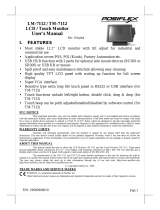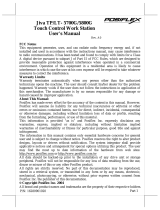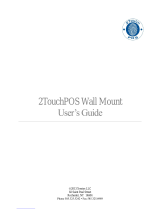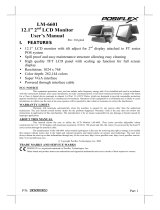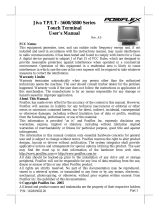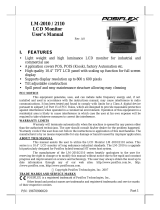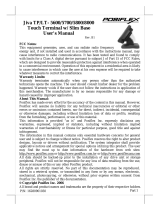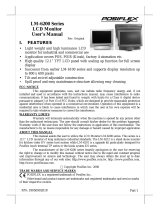Page is loading ...

Part 1
FCC NOTICE
This equipment generates, uses, and can radiate radio frequency energy and, if not installed and used in
accordance with the instructions manual, may cause interference to radio communications. It has been tested and
found to comply with limits for a Class A digital device pursuant to subpart J of Part 15 of FCC Rules, which are
designed to provide reasonable protection against interference when operated in a commercial environment.
Operation of this equipment in a residential area is likely to cause interference in which case the user at his own
expense will be required to take whatever measures to correct the interference
.
WARRANTY LIMITS
Warranty will terminate automatically when the machine is opened by any person other than the authorized
technicians. The user should consult his/her dealer for the problem happened. Warranty voids if the user does not
follow the instructions in application of this merchandise. The manufacturer is by no means responsible for any
damage or hazard caused by improper application.
ABOUT THIS MANUAL
This manual assists the user to utilize the TM/LM-2012X. This product provides exquisite touch control
capability over a Stable and adjustable LCD monitor with minimal footprint.The manufacturer of the TM/LM-
2012x monitor heartily apologizes to the user for reserving the right to change or to modify this manual without
notice due to the rapid and constant progress and improvement on science and technology. The user may always
obtain the most up to date information through any of our web sites: http://www.posiflex.com,
http://www.posiflex.com.tw, http://www.posiflexusa.com.
Copyright Posiflex Technology, Inc. 2013
TRADE MARKS AND SERVICE MARKS
POSIFLEX is a registered trademark of Posiflex Technology, Inc.
Other brand and product names are trademarks and registered trademarks and service marks of their
respective owners.
I. FEATURES
• Application covers POS, Factory Automation etc.
• Most stable 12” LCD monitor with tilt adjustment for industrial and
commercial use.
• High quality TFT LCD panel.
• Easy maintenance structure allowing easy cleaning.
• Resolution up to 1024 x 768 pixels.
• Resistive type extra long life touch panel in USB interface (for TM-2012X)
• Touch functions include left/right button, double click, drag & drop (for
TM-2012X).
TM/LM-2012X
LCD Monitor
User’s Manual
Rev. Original
P
/N:
196
7
090
5
0
1
0

Part 2
II. CARTON CONTENTS
1. Touch Monitor (Main unit + Adjustable base stand assembly)
2. User’s Manual
3. VGA cable
4. USB cable
5. Option power adaptor: 12 V DC & power cord
6. Posiflex Product Information CDROM
7. Option wall mount kit
III. PARTS IDENTIFICATION
A. FRONT VIEW
LED indicator: Power-On mode: Blue
Power-Off mode: None
Sleep mode: Green
B. REAR VIEW
Power LED
Display Screen
Main Unit
Hinge
Cover
Main Unit
Base Stand
Control button area
Cable Exit
Inside Base
Oval Cable Passage

Part 3
C. SIDE VIEW (control button area)
IV. INPUT / OUTPUT PORTS
V. HARDWARE INSTALLATION
A TILTING LCD PANEL
The tilting mechanism in LM/TM-2012X utilizes
hinges and there is no particular skill to turn the LCD
panel to most suitable angle for either viewing or
convenience in cable connection/ disconnection.
B DISCONNECTING ALL CABLES
With the LCD/touch panel turned to most backward position, the main I/O
connector area will be easily accessible at bottom side of the main unit. Please
first note orientations of every existing cable connection and then
disconnect every cable properly before any further reconfiguration of cable
connections.
Control Button Area
OSD button
EXT button
“+” button
“-“ button
Power switch
VGA input
USB (B) (to Host)
12 V DC input
USB (A) (to Devices)

Part 4
C OPENING BASE BACK COVER
In order to settle the LCD panel properly in a point
of sale system, all the cable connections have to be
routed through its base. Therefore, please observe
the side view pictures of the base trunk at the right
and release the triangle marked hooks to remove the
back cover.
D CABLE ROUTING IN BASE
For cable routing in the mini slim base, please
refer to the picture at left. There is a cable tie inside
the base trunk as arrowed in the picture. Hold all the
external cables with the cable tie. Have all cables to
pass through the oval hole on the trunk as triangle
marked to come out of the front side of trunk. Connect
all the cable ends to main unit.
E Option Wall Mount Kit
After release the stand’s back cover, please unfasten
these three screws to remove the main structure of base
stand which marked in the right picture.
After that, please use flat drill to release the hinge
cover from the arrowed side as show in the right picture.
Next, unfasten these four screws which fix the hinge
as show in the right picture and remove the hinge.
Fix the 4 shoulder screws that comes with the wall
mount bracket at the 4 arrowed marked holes in right
picture to prepare for locking into the bracket. Then the
main unit is ready for wall mounting, please follow the
installation guide that also comes with the wall mount

Part 5
bracket to fix the wall mount bracket on wall and then hang the main unit with
the matching pegs into the matching holes on wall mount bracket.
VI. DRIVER INSTALLATION
A. INSTALLATION
The USB interface touch controller operates as an USB mouse without need
for any special driver in Windows. However, there is a program supported for
its calibration and touch function manipulation. Please find it in the attached
Posiflex product information CD-ROM under subdirectory
\Drivers\TM_LM\USB or select “Peripheral Drivers & Utilities” then “USB
Touch Manager” of “TM series” depending on the version of the CD-ROM.
For Linux environment, please find the setup program for the suitable kernel in
the same directory and install the required driver and calibration program as
the setup program proceeds.
B. POSIFLEX USB TOUCH MANAGER
a.
USB touch manager
Once the USB control program is installed, the user can utilize it to calibrate
the touch screen, define mouse button emulation parameters, enable right
button emulation or define the click sound’s tone and duration. Please go to
“Program Files” and select “Posiflex USB Touch Tools” and then select
“Posiflex USB Touch Manager” within the tools to engage this utility. Most
items in this utility should be easily understandable to average user.
Followings are just some reminders on some items.
Calibrate – This button engages the “Posiflex USB Touch
Calibrator”.
Hide Cursor – This button hides or shows the mouse cursor on
screen display. Please never hide cursor before the touch is enabled
and calibrated.
Restore Defaults – This button resets all touch parameters to default
settings.
Edge Accel. – This function engages the “Posiflex USB Touch Edge
Acceleration Tool” and helps to find the hidden taskbar or thin scroll
bar through touch.
Enable Touch – This check box must be checked to have the touch
panel working.
Enable Touch_to_Calibrate – This check box provides a shortcut

Part 6
for touch calibrator by holding touch for a programmed time delay.
However, this function denies the touch mode of “Click on Release”.
Enable Buzzer – This check box enables the internal buzzer beep as
response to touch on touch panel.
Enable Frequency – This selection box selects the buzzer tone by
up/down arrows beside the box.
Enable Duration – This selection box selects the length for the touch
beep by up/down arrows beside the box.
Double Click Area – This selection box selects the size of touch
point on touch panel by up/down arrows beside the box. A too small
touch size makes the double click operation difficult. A too large
touch size results in unsatisfactory touch accuracy.
Time delay to Touch_to_Calibrate – This selection box defines the
touch time required for a shortcut to Touch Calibrator by up/down
arrows beside the box when the “Enable Touch_to_Calibrate” check
box is checked.
Touch Mode Setting – Only one of the three radio buttons can be
selected. The mouse emulation refers to the drag and drop function.
OK – This button accepts all parameters set and closes the utility
window.
Apply – This button accepts all parameters set and remains in the
utility window.
Cancel – This button discards all changes to the parameters and
closes the utility window.
Help – This button provides explanations.
b.
USB touch calibrator
This program helps re-calibrating the touch position with the USB mouse
emulation. Please touch the calibration targets at each corner and a
confirmation box that appear sequentially.
c.
USB touch edge acceleration tool
Helps to find the hidden taskbar or thin scroll bar through touch
Enable ... – Each check box determines whether or not to engage
edge acceleration against which edge of screen.
Margin – This list button selects the range to engage edge
acceleration toward the edge before the edge is reached.
Compensation – This list button selects the distance to advance the
mouse toward edge from touch point.

Part 7
d.
USB touch right button tool
This tool differs slightly from the “Touch as Right Button Click” check box in
the USB touch manager. When executed, there will be a small window of
“One Shot Right Button” appearing on desktop. Any touch on the panel right
after touching this small window will work like clicking the right button of
mouse at that point. However, the next touch will resume the left button of
mouse unless the small window is touched again.
C. APPLICATION LIMITATION
The USB touch is not applicable for OS other than Windows as USB mouse is
not supported in DOS environment. The USB touch is also not applicable
when the monitor is used to be the extended screen in multiple monitor
application.
In using the MSR of the side mounted upgrade option for reading a magnetic
stripe card, be sure to insert the card to the bottom with magnetic stripe facing
the mark aside the slot. The movement of the card can be either inserting the
card from the top surface then sliding the card down out of the slot, or sliding
the card upward from the lower side of the slot till it reaches the top end as
long as the card is a standard one. A non-standard card recorded without
complete degaussing prior to recovery may accept only one direction in card
reading.
If the fingerprint sensor option is installed in the side mount kit, please find the
most comfortable angle for the fingerprint taking operation in consideration of
the LCD panel tilt angle and try to align the core of fingerprint in the sensing
area.

Part 8
VII. OSD
(ON SCREEN DISPLAY) SCREEN ADJUST FUNCTION
A. Power & OSD buttons
The buttons at the left side of LCD monitor are for the OSD
(On Screen Display) control operations and LCD screen power
control as in the right picture and are explained below. “OSD”
button: To enter OSD setup menu, or to perform the function
selected in OSD operation.
“OSD” button: To enter OSD menu
“EXT” button: To Exit the option functions
“” “” button: To increase setting.
“” “” button: To decrease setting (in OSD mode) /
Auto tune (in normal mode).
“” “” button: To turn the monitor power ON/OFF.
The monitor can be turned OFF only when there is video signal and can be
turned ON only when there is video signal The default status is set to ON
when power is supplied unless manually turned OFF. Since this button
controls only the display power but not the display controller neither the
touch controller, please try disconnect the power cable or the VGA cable
once unfortunately the screen display goes into a mess.
B. OSD functions
Press “OSD” button with a normal display on the screen to activate the OSD
functions then the OSD window will pop up on the screen as below. The OSD
(on-screen display) is a collection of menus and controls used for adjusting the
appearance and setup of monitors such as Contrast, Brightness and Color.
Please use these OSD buttons to adjust these settings.
“MAIN MENU”: There are a total of 6 icons in this menu:
Once one icon is selected, it will be displayed in inverted color to indicate its
relationship with the submenu below. On the physical panel side bar of LCD
monitor display, pressing “EXT” button will shift the selected icon one by one
from left to right and then wrap around to the leftmost part. Press “OSD”
button to enter the selected sub menu. Items in sub menu are illustrated below.
Press “+”/”-“ to adjust.

Part 9
“BRIGHTNESS / CONTRAST ADJUST SUBMENU”: There
are2 icons in this submenu:
“BRIGHTNESS ADJUST”: When this item is selected, there will
be only the brightness icon with an adjustment indication bar under it
between the main menu area and the video signal mode. Press “+”
button to increase brightness. Press “-” to decrease. Press “OSD” button
to save the current setting and return to “Brightness/Contrast submenu”.
“CONTRAST ADJUST”: When this item is selected, there will be
only the contrast icon with an adjustment indication bar under it
between the main menu area and the video signal mode. Press “+”
button to increase contrast. Press “-” to decrease. Press “OSD” button
to save the current setting and return to “Brightness/Contrast submenu”.
“IMAGE POSITION”: There are 2 icons in this submenu:
“Horizontal Position”: When this item is selected, there will be
only the position icon with an adjustment indication bar for user to
adjust. Press “+” button to move image rightward for horizontally
rightward positioning. Press “-“ button to move image leftward for
horizontally leftward positioning. Press OSD/EXT to save/exit.
“Vertical Position”: When this item is selected, there will be only
the position icon with an adjustment indication bar for user to adjust.
Press “+” button to move image upward for horizontally upward

Part 10
positioning. Press “-“ button to move image downward for horizontally
downward positioning. Press OSD/EXT to save/exit.
”IMAGE SETUP”: There are 2 icons in this submenu:
“Image Setup”: When this item is selected, there will show an
automatic image setup screen to automatically optimize this image.
“Manual Image Setting”: When this item is selected, there will
show a manual image settings display for user to manually configure
“Clock” and “Phase”.
”IMAGE PROPERTY”: There are 2 icons in this submenu:
“Image RGB intensity”: When this item is selected, there
will show a customized window display for user to adjust
RGB intensity.
“Image Scaling”: When this item is selected, there will show
a scaling image display window for user to resize screen display.
”OPTIONS”: There are 5 icons in this submenu:
“Resolution, Refresh Rate & Product Detail”: When this item is

Part 11
selected, there will show a compact product detail about resolution and
refresh rate for demonstration.
”Change Language of Menu”: When this item is selected,
there will show a multilingual menu for user to opt for
desired language option.
“Factory Default”: When this item is selected, there will show a
Factory Default menu for user to restore to original monitor settings.
.
“Accessibility”: When this item is selected, there will show an
Accessibility menu for user to change menu time-out setting.
“EXIT”: Exit OSD setup with all adjustment saved.

Part 12
VIII. SUPPORTED DISPLAY MODES
For VGA signals beyond the supported display modes, there will be a message
“Out Of Range” on the middle of screen. Maximum supported color depth is
18 bits or 262,144 colors. Supported display modes are illustrated in the table:
Display Resolution
Refresh Rate (Hz)
Horizontal Frequency (KHz)
640*400 70 37.9
60 31.5
72 37.9
640*480
75 37.5
720*400 70 37.9
56 35.1
60 37.9
72 48.1
800*600
75 46.9
60 48.4
70 56.5
1024*768
75 60
T31454
/
